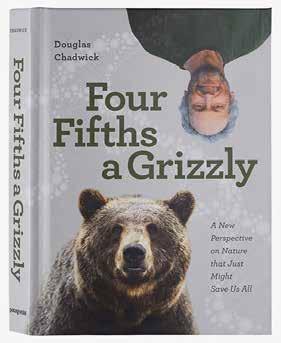
3 minute read
Book Reviews
BOOK REVIEW
DOUGLAS CHADWICK
by Ken DuBois
No offense, but you and I are about as individual as a standard-issue postage stamp. That’s a key message in Douglas Chadwick’s engaging new book, Four Fifths a Grizzly, a lushly illustrated essay collection in which he explores the interconnectedness of life on earth, from the mammoth to the microscopic. And to diminish any notion we may have about our uniqueness, he starts with a humbling primer on common genes. We share about 97 percent of our genetic material with a chimpanzee, Chadwick notes, and about 30 percent with the banana he’s eating.
But Chadwick’s goal with Grizzly is to inspire. He has a strong conservation message, and a call to action that depends on our ability to see ourselves as part of nature and see nature as part of us. “You, every friend, enemy, lover, dignity, and desperado along with every other animal, every plant, and every fungus you’ll ever meet, exist as a union,” Chadwick writes. In place of individualism, he encourages us to embrace the concept of the “greater self,” and he means that literally when reminding us about the multitudes of helpful microbes living in and on our bodies, a veritable army of organisms that make us “a kind of compound creature.”
Having placed Homo sapiens in context, Chadwick devotes most of Grizzly to the non-human creatures and organisms that fascinate him, and the lengths to which he goes to observe and understand them. Regular readers of National Geographic know Chadwick for his outdoor adventure stories, and many of his conclusions in Grizzly are based on similar exploits. His fascinating essay on elephants begins with a high-speed chase in a Kenyan national park as he rides with a patrol unit on the trail of ivoryraiding bandits; he braves rough seas in the Atlantic, hundreds of miles off Nova Scotia, as part of a crew trying to learn more about northern bottlenose whales; and in a skiff near the Channel Islands off California, he has a chance encounter with the largest animal to have ever existed, a blue whale. He’s a self-professed “adrenaline junkie,” but a thoughtful one; each encounter confirms his belief that we are all in this together.
Most engaging in Grizzly are Chadwick’s examples of symbiosis, the phenomenon of plants and animals working together to create a mutually beneficial chain of events, a sort of organic Rube Goldberg machine. A tree nut goes in one end of the elephant and comes out the other; dung beetles form the waste into a ball and roll it home to store underground; a new tree takes root in ideal conditions. The acacia tree grows sweet pods that attract ants and hollow thorns where they can nest, effectively creating an in-house security system to ward off leaf-eating intruders. And the chain of life that flows from strawberry plants is so complex, in Chadwick’s telling, he devotes two chapters to the subject, starting with a basic evolutionary question: Do they really need to be as scrumptious as this? (His conclusion: Yes, they do.)
The subject of strawberries also provides a way for Chadwick to bring us back to his original theme of the compound creature; because they share roots, strawberry plants in close proximity are really “clones,” as are groves of elms and aspen. He stops short of using the same term for humans, but does make the point that collectively—with shared behaviors and inclinations—we are playing an outsized role in disrupting the unity of the natural world. “This destructive pattern probably won’t change,” Chadwick writes, “until we change we way we think about our relationship to nature.”
Chadwick, Douglas. Four Fifths a Grizzly: A New Perspective on Nature that Just Might Save Us All. Ventura, California: Patagonia Works, 2021. Mazama Library number 551.6 C34.








